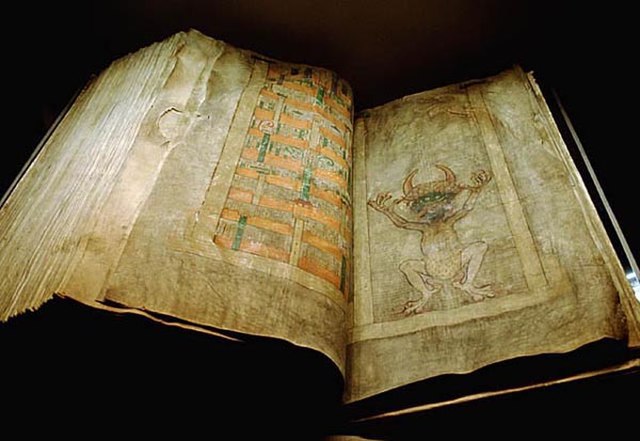
A Giant Book
At 36 inches tall, 20 inches wide, and 8.7 inches thick, bound by leather-covered wooden boards, containing 310 pages made from vellum of 160 donkeys, and weighing an astonishing 165 lbs, the Codex Gigas or Giant Book is the largest medieval book in the world, but believe it or not, that’s not the only thing that makes it unique. The real mystery comes from the contents within its pages.
The manuscript includes the complete Vulgate Bible, as well as an amalgamation of several other very popular medieval works which lie in the pages between the old and new testaments; two works of Josephus Flavius, Isidore of Seville’s Etymologies, the Ars of Medicine a book of standard medical teachings for the time, the chronicle of Cosmas of Prague, and a calendar, all written in Latin.
Although completion of the book by just one person certainly would have amounted to an almost impossible undertaking considering the amount of intricate detail within its pages, scholars believe it to be the work of just one scribe whose identity has been lost to time, though it is thought to have been created in the Benedictine monastery of Podlažice in Bohemia in the Czech Republic sometime in the early 13th century.

The Devils in the Large Details
The Devil’s Bible gets its name from one singular page depicting a nineteen-inch portrait of the devil himself. In the portrait, the devil is naked save an ermine loincloth. Being that Ermine is associated with royalty it is assumed this choice is meant to signify that the devil is the Prince of Darkness. Opposite the portrait lies the depiction of a heavenly city thought to be Jerusalem as mentioned in the Book of Revelation. Possibly with the intent of illustrating living a God-fearing life on one page and the consequences of sin on the other.
As legend Has It
Due to its grand depiction of the devil and the seemingly vast amount of time it would have taken to complete the book, coupled with the fact that its writings remain unchanged throughout its creation, showing no signs of age or mood on part of the scribe, many myths have been attributed to the book’s creation. The most famous of these is; as a monk, Herman the Recluse, was awaiting his fate, sentenced to be walled up alive as punishment for breaking his monastic vows, he promised to create a great book that would glorify the monastery forever and no doubt ultimately stave off his punishment, and what’s more, he would accomplish it all by morning. However, as midnight was fast approaching and the monk was nowhere near completing the task he promised, he made a special prayer to the one deity he knew could save him from his fate. In the prayer, he bargained his soul to the devil and in turn, was given the power to complete the entire work in just one night.
Could it Really Be Done?
Tests conducted over the years to verify exactly how long it would take to recreate the manuscript concluded that if one were to reproduce only the calligraphy, excluding all illustrations and additional embellishments, it would take twenty years of non-stop writing to complete.
Comments